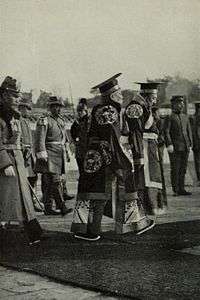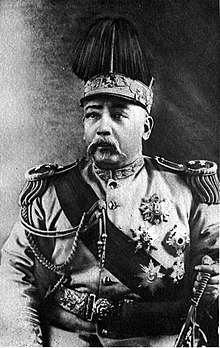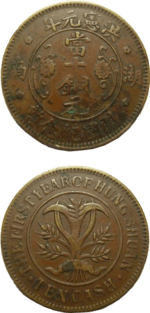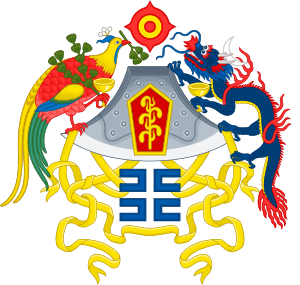Empire of China (1915–1916)
The Empire of China was a short-lived attempt by statesman and general Yuan Shikai from late 1915 to early 1916 to reinstate monarchy in China, with himself as the Hongxian Emperor (洪憲皇帝; Hóngxiàn Huángdì). The attempt was unsuccessful; it set back the Chinese republican cause by many years and fractured China into a period of conflict between various local warlords.
Empire of China 中華帝國 Chunghwa Tikuo | |||||||||
|---|---|---|---|---|---|---|---|---|---|
| 1915–1916 | |||||||||
.svg.png) | |||||||||
| Capital | Peking 39°54′N 116°23′E | ||||||||
| Largest city | Shanghai | ||||||||
| Official languages | Standard Chinese | ||||||||
| Religion | Heaven worship | ||||||||
| Government | Absolute monarchy | ||||||||
| Emperor | |||||||||
• 1915–1916 | Hongxian Emperor | ||||||||
| Prime Minister | |||||||||
• 1915–1916 | Lou Tseng-Tsiang | ||||||||
| Historical era | World War I | ||||||||
• Formed | 12 December 1915 | ||||||||
| 25 December 1915 | |||||||||
• Abolition of the Empire | 22 March 1916 | ||||||||
• Death of Yuan Shikai | 6 June 1916 | ||||||||
| Currency | Chinese Yuan | ||||||||
| ISO 3166 code | CN | ||||||||
| |||||||||
| Empire of China | |||||||||
|---|---|---|---|---|---|---|---|---|---|
| Traditional Chinese | 中華帝國 | ||||||||
| Simplified Chinese | 中华帝国 | ||||||||
| Postal | Chunghwa Tikuo | ||||||||
| Literal meaning | Chinese Emperor Nation | ||||||||
| |||||||||
Preparations for formation

After Yuan Shikai was installed as the second Provisional Great President of the Republic of China, he took various steps to consolidate his power and remove opposition leaders from office. To secure his own power he collaborated with various European powers as well as Japan. Around August 1915, he instructed Yang Du (楊度) et al. to canvass support for a return of a monarchy. On 11 December 1915, an assembly unanimously elected him as Emperor. Yuan ceremonially declined, but "relented" and immediately agreed when the National Assembly petitioned again that day.[1] On 12 December, Yuan, supported by his son Yuan Keding, declared the Empire of China with himself as the "Great Emperor of the Chinese Empire" (simplified Chinese: 中华帝国大皇帝; traditional Chinese: 中華帝國大皇帝; pinyin: Zhōnghuá Dìguó Dà Huángdì), taking the era name Hongxian (simplified Chinese: 洪宪; traditional Chinese: 洪憲; pinyin: Hóngxiàn, "Constitutional Abundance"). However, Yuan, now known as the Hongxian Emperor, delayed the accession rites until 1 January 1916. He had Manchurian clothes removed from culture and had Han Chinese clothes revived but had put some changes to it. He wore new Han clothes to attend a dress rehearsal. A dress rehearsal was sabotaged by his Korean concubine. Soon after, the Hongxian Emperor started handing out titles of peerage to his closest relatives and friends, as well as those whom he thought he could buy with titles.
The Aisin Gioro family of the Qing dynasty, then living in the Forbidden City, "approved" of Yuan's accession as emperor, and even proposed a "royal marriage" of Yuan's daughter to Puyi, the last Qing monarch.
Backlash

The year 1916 was to be "Hongxian Year 1" (洪憲元年) rather than "Republic Year 5" (民國五年),[1] but the Hongxian Emperor was opposed by not only the revolutionaries, but far more importantly by his subordinate military commanders, who believed that Yuan's assumption of the monarchy would allow him to rule without depending on the support of the military.
Province after province rebelled after his inauguration, starting with Yunnan, led by the emperor's governor Cai E and general Tang Jiyao and Jiangxi, led by governor Li Liejun. The revolters formed the National Protection Army (護國軍) and thus began the National Protection War. This was followed by other provinces declaring independence from the Empire. The emperor's Beiyang generals, whose soldiers had not received pay once from the imperial government, did not put up an aggressive campaign against the National Protection Army and the Beiyang Army suffered numerous defeats despite being better trained and equipped than the National Protection Army.
Seeing the Hongxian Emperor's weakness and unpopularity, foreign powers withdrew their support (but did not choose sides in the war). The Empire of Japan first threatened to invade, then committed to overthrowing the Hongxian Emperor and recognised both sides of the conflict to be "in a state of war" and allowed Japanese citizens to help the Republicans.[1] Faced with universal opposition, the emperor repeatedly delayed the accession rites to appease his foes. Funding for the ceremony was cut on 1 March. Yuan deliberated abandoning the monarchy with Liang Shiyi on 17 March and abandoned it on 22 March. The "Hongxian" year was abolished on 23 March and the Republic was restored.[2] Yuan reigned a total of 83 days.[1]

After Yuan's death on 6 June Vice President Li Yuanhong assumed the presidency, and appointed Beiyang general Duan Qirui as his Premier and restored the National Assembly and the provisional Constitution. However, the central authority of the Beijing government was significantly weakened and the demise of Yuan's Empire plunged China into a period of warlordism.
National symbols
.svg.png)
Although the name of the country in Chinese was changed to the "Empire of China" (and "Hongxian" for state matters), the Hongxian Emperor continued to use "Republic of China" as the English name.[1]
The Hongxian Emperor set up the Ritual Regulations Office (禮制館), which issued the new official anthem for the Republic of China "China heroically stands in the Universe" (中華雄立宇宙間) in June 1915. Its lyrics were written by Yin Chang (廕昌) and music by Wang Lu (王露). The lyrics were slightly modified in December 1915, with 共和五族 (Five Races Under One Union) replaced by 勳華揖讓 (Shanrang, the ancient system of Chinese emperor relinquishing seats to others in Yao and Shun's era) to be used during the Hongxian Emperor's reign.
| Chinese lyrics | English translation |
|---|---|
|
中華雄立宇宙間, |
China heroically stands in the Universe, |
Yao was a legendary Chinese ruler. The era of Yao and Shun (堯天舜日) is a Four-character idiom which means times of peace and prosperity.
The national flag was changed from the original 5-stripe flag to one where the red stripe is a centered cross; however, a flag with the former red stripe as a saltire was the version commonly used.
The national emblem remained as the national emblem of the Republic of China (1913–1928), National emblem of Twelve Symbols of Sovereignty (十二章國徽).
List of people given peerage by the Hongxian Emperor

Crown Prince (皇太子)
- Yuntai (云台)
Prince of the First Rank Wuyi (武義親王 Wǔyì qīn wáng)
- Duke Yansheng Kong Lingyi (衍聖公 孔令貽)[4]
- Li Yuanhong (黎元洪)
Dukes of the First Rank (一等公 Yī děng gōng)
- Duan Zhigui (段芝貴)
- Feng Guozhang (馮國璋)
- Jiang Guiti (姜桂題)
- Liu Guanxiong (劉冠雄)
- Long Jiguang (龍濟光)
- Ni Sichong (倪嗣衝)
- Zhang Xun (張勳)
Marquesses of the First Rank (一等侯 Yī děng hóu)
- Chen Yi (陳儀)
- Li Chun (李純)
- Lu Rongting (陸榮廷)
- Tang Jiyao (唐繼堯)
- Tang Xiangming (湯薌銘)
- Wang Zhanyuan (王占元)
- Yan Xishan (閻錫山)
- Zhao Ti (趙倜)
- Zhu Rui (朱瑞)
Counts of the First Rank (一等伯 Yī děng bó)
- Cao Kun (曹錕)
- Jin Yunpeng (靳雲鵬)
- Lu Jianzhang (陸建章)
- Meng Enyuan (孟恩遠)
- Qi Yaolin (齊耀琳)
- Qu Yinguang (屈映光)
- Tian Wenlie (田文烈)
- Yang Shande (楊善德)
- Yang Zengxin (楊增新)
- Zhang Mingqi (張鳴岐)
- Zhang Xiluan (張錫鑾)
- Zhu Jiabao (朱家寶)
Viscounts of the First Rank (一等子 Yī děng zǐ)
- Li Houji (李厚基)
- Liu Xianshi (劉顯世)
- Zhang Guangjian (張廣建)
- Zhu Qinglan (朱慶瀾)
Barons of the First Rank (一等男 Yī děng nán)
- Cai Rukai (蔡儒楷)
- Chen Bingkun (陳炳焜)
- Duan Shuyun (段書雲)
- He Zonglian (何宗蓮)
- Jin Yong (金永)
- Long Jianzhang (龍建章)
- Long Jinguang (龍覲光)
- Lu Yongxiang (盧永祥)
- Lü Diaoyuan (呂調元)
- Ma Anliang (馬安良)
- Pan Juying (潘矩楹)
- Qi Yang (戚揚)
- Ren Kecheng (任可澄)
- Shen Jinjian (沈金鑑)
- Wang Yitang (王揖唐)
- Xu Shiying (許世英)
- Zhang Huaizhi (張懷芝)
Baron of the Third Rank (三等男 Sān děng nán)
- Feng Yuxiang (馮玉祥)
- He Fenglin (何丰林)
- Xu Lanzhou (許蘭洲)
See also
- Warlord era
- History of the Republic of China
- Self-proclaimed monarchy
- Military of the Republic of China
- National Protection War
References
- Kuo T'ing-i et al. Historical Annals of the ROC (1911–1949). Vol 1, pp. 207–41.
- Shan, Patrick Fuliang (2018). Yuan Shikai: A Reappraisal, The University of British Columbia Press. ISBN 9780774837781.
- 中國的旗幟 (Flags of China) (in Chinese)
- Parker, Edward Harper (22 May 2018). "China, her history, diplomacy, and commerce, from the earliest times to the present day". N.Y. : Dutton – via Internet Archive.
External links

| Preceded by Republic of China |
Empire of China 1915–1916 |
Succeeded by Republic of China |
.svg.png)
